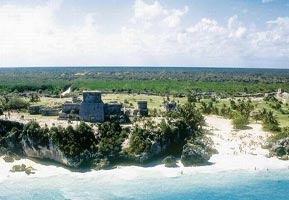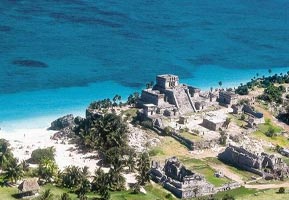Tulum
In the extreme south of the Riviera Maya, from the imposing ancient walled
city of Tulum to the entrance of the Sian Ka’an Biosphere Reserve, extends a
ribbon of tranquil beaches, bathed on one side by the turquoise waters of the
Caribbean Sea and framed on the other by the jade-tinged tropical jungle. They
offer alternative ways to become familiar with and enjoy the natural wonders and
fascinating history of these privileged coasts.
The small hotels found here focus mainly on ecotourism and sustainable
development, and promote nature. Whether you choose to stay in a luxurious or
more rustic bungalow, in Tulum you live in communion with the natural world.
Showers pour waters from the cenotes or sinkholes, dinner often vegetarian is
accompanied by delicate candlelight and a siesta can be taken in a hammock
strung between two palm trees.
In the summer, nights with a full moon offer the
unparalleled experience of witnessing numerous sea turtles that come ashore to
nest on the beaches.. |

Tulum

Tulum Mexico
|
|
Nestled within the palms, facing the vast ocean, cozy palm-thatched huts or
palapas, have sand floors and beds which hang from the ceiling beneath roomy
mosquito nets. Cooled by the sea breeze that flows freely through the bungalow
and joined by the soothing sound of the waves, a peaceful slumber is ensured.
There are ma-ny attractions in this magic region. Upon rising, facing a new
dawn, a session of meditation on the beach provides the necessary energy to last
through the day. It is also easy to find different types of massages and
relaxation therapies: reflexology, aromatherapy, tai chi, reiki, tarot readings,
etc.
To enter the jungle is to come face-to-face with its flora and fauna, and to
discover the wondrous world of the cenotes: natural crystalline freshwater
pools, some within amazing caves, surrounded by mangrove forests. Cenotes are
gates to the mysterious labyrinth of rivers that extend beneath the Yucatan
Peninsula. Only a few intrepid professional divers accompanied by specialized
guides have explored them. The world’s second-largest barrier reef runs a few
feet off shore. Organi-zed diving or snorkeling tours to discover these
fabulously biodiverse underwater gardens can be arranged at the beach or in
town.
Less than a mile from the beach, the town of Tulum is set apart by its
relaxed ambience, its tiny restaurants offering homecooked meals and its
tasteful handicraft shops. From the intersection at the entrance of town to the
archaeological park of Coba, 27 miles away, lies a picturesque highway bordered
by various typical Mayan villages dedicated to the handicraft industry. The
Mayans of today have preserved the cultural characteristics of their ancestors
and like them, respectfully take advantage of the re-gion’s natural resources.
The glorious past of this ancestral culture is evident in every corner of the
ancient city of Tulum. Located strategically over a steep cliff facing the
ocean, it was built in 1200, but experienced its golden age during the century
before the Conquest. In 1518, a Spanish expedition led by Juan de Grijalva was
navigating along the Caribbean coast when his sailors warned him of several
large settlements. One stood out among them due to its size and beauty which
they compared to Seville: it was most likely Zama (Tulum-Tankah).
The name originally means “dawn,” in reference to the sun that each day
awakens over the sea, offering an exceptional natural spectacle. At that time,
Tulum was a densely populated maritime port that, aside from its bustling
commercial activity throughout the year, had important religious, political and
social ties that extended as far as northern Mexico and Panama. The majority of
buildings were painted in lively colors and covered in stucco both inside and
out. Impressive murals are well preserved in the Temple of the Frescoes,
depicting themes of cosmology and fertility. In addition, its exterior is
decorated with large masks.
The architecture of; Tulum is especially original because of its tiny
temples of principally religious character. It is believed that the miniature
constructions found facing the Caribbean Sea served as a refuge for sailors.
Nights in Tulum invite you to sit silently on the beach and dream of the
splendorous past of a millenary culture, admire the dance of the moon and stars
over the waves and listen to the sounds of the vibrant jungle. Parties
spontaneously come together to the rhythm of drums around a bonfire, beneath the
starry sky of this paradise |